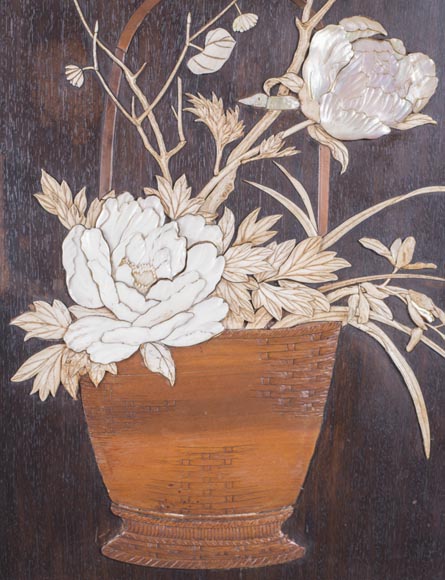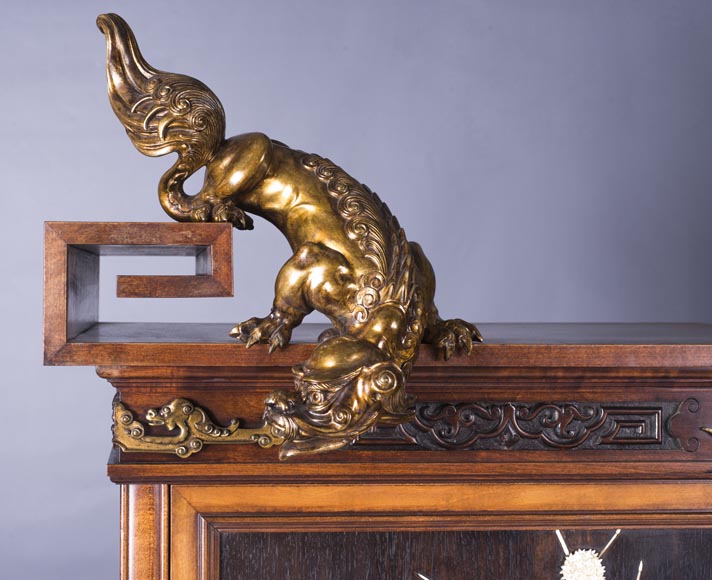Style Japonism, Chinoiserie / Ref.11321
Gabriel VIARDOT (1830-1906) - Large Japanese cabinet with Foo dog
Dimensions
Width 51'' ⅝ 131cm
Height 72'' ⅞ 185cm
Depth: 20'' ½ 52cm
Origin:
France, Late 19th century
This exceptional Foo dog cabinet is signed by Gabriel Viardot. Its asymmetrical construction is characteristic of the creations of the Parisian cabinetmaker. The composition alternates solid elements and empty spaces. The central door is decorated with a panel inlaid with ivory, tinted bone and wood composing a bouquet of flowers. This panel probably came from a Japanese furniture piece and was reused, a common practice by Gabriel Viardot, to make this piece. This was also the case for the element adorning the left panel. A frightening character, of a rare plastic quality, is produced in ivory and mother of pearl. The decorative element the most exceptional of this cabinet is a Fu dog crowning the piece. To the right of the piece, supported by a shelf, a crane resting on the back of a tortoise is also made in polished varnished bronze just like the sinuous dragon located in the lower part of the piece. One also finds small elements of latticed polished varnished bronze decorated in their center with a pinecone in this piece. These are, like the scrolled feet, elements frequently present on the pieces of Gabriel Viardot.
Gabriel Viardot was a famous Parisian cabinetmaker specialized in the production of “Chinese-Japanese style” furniture in the last third of the 19th century. He started his wood-sculpting career in 1849, when he sent some furniture pieces in natural décor to the horticultural exhibition. He then became the head of a small team of sculptors when he was just 19 years old. In 1853, he had a factory and a store of furniture located at 36 and 38 Rambuteau Road. During this time, he worked with his brother, Louis Gustave, under the name “Viardot Brothers and Company.” In 1860, he created his own workshop, “G. Viardot” at 5 Grand-Chantier road, and became head of the family business that he kept until 1872. He decided to devote himself to “Chinese-Japanese style furniture,” which he was able to observe mainly at the 1867 World Exposition. At this same exposition, he was awarded four medals. It’s with this production that he was awarded at the 1878 World Exposition with a silver medal. Following that, he practiced consecutively at 15 Chaume road, 3 Archives road in 1878 and 36 Amelot road near the end of the century. His furniture was produced thanks to lacquered and carved panels sent directly from China or Japan and decorated with mother of pearl inlays from Tonkin. He enlivened his furniture with bronze decorations, of which he made all the designs by hand. Over the course of the years, the success only continued to grow, particularly at the expositions of Nice and the 8th exposition of the Central Union of Decorative Arts in 1884. In 1885, he participated in the World Exposition of Antwerp where he obtained a gold medal. At this time, the shop employed 90 – 100 workers, sculptors or cabinetmakers, a lot of who were educated directly by Gabriel Viardot. Following this exposition, he was promoted to the rank of Knight in the Legion of Honor (December 29 1885). In 1889, he was at the World Exposition that took place in Paris and awarded a gold medal. He obtained the same award at the 1900 World Exposition.
Informations
Price: on request
Recommended for you :
Dimensions:
Width: 83
Height: 179
Depth: 45
Dimensions:
Width: 119
Height: 171
Depth: 46
Dimensions:
Width: 130
Height: 182
Depth: 24
Dimensions:
Width: 84
Height: 186
Depth: 49
Dimensions:
Width: 110
Height: 173
Depth: 44
Dimensions:
Width: 53
Height: 138
Depth: 34
Dimensions:
Width: 75
Height: 158
Depth: 47
Dimensions:
Width: 124
Height: 148
Depth: 47
Dimensions:
Width: 128
Height: 218
Depth: 44
Dimensions:
Width: 168
Height: 235
Depth: 55
Dimensions:
Width: 98
Height: 204
Depth: 43
Dimensions:
Width: 241
Height: 351
Depth: 120





























